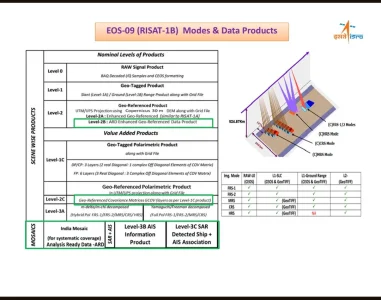- Joined
- Jul 8, 2024
- Messages
- 940
- Likes
- 1,753

EOS-09 satellite set to be launched on May 18, will boost India’s border surveillance powers | India News - The Times of India
India News: India's surveillance capabilities are poised for a significant boost with ISRO's upcoming launch of the EOS-09 (RISAT-1B) radar imaging satellite on M
EOS-09 satellite set to be launched on May 18, will boost India’s border surveillance powers
Surendra Singh / TNN / Updated: us
India's surveillance capabilities are poised for a significant boost with ISRO's upcoming launch of the EOS-09 (RISAT-1B) radar imaging satellite on May 18. Equipped with advanced C-band synthetic aperture radar, the satellite will provide high-resolution images regardless of weather conditions. This strengthens border surveillance along sensitive areas with Pakistan and China, while also aiding in anti-terror operations and coastal monitoring.
EOS-09 satellite set to be launched on May 18, will boost India’s border surveillance powers
Isro is scheduled to launch the EOS-09 (RISAT-1B) satellite on May 18
NEW DELHI: India’s surveillance power from the sky is set to get a big boost as Isro is scheduled to launch the PSLV-C61 mission carrying the EOS-09 (RISAT-1B) radar imaging satellite into a sun-synchronous orbit on May 18. The launch is scheduled at 6.59 am IST from the Satish Dhawan Space Centre in Sriharikota.
The surveillance satellite will strengthen India’s Earth observation capabilities as EOS-09 is equipped with a state-of-the-art C-band synthetic aperture radar, enabling it to capture high-resolution images of Earth’s surface, regardless of weather conditions.
The satellite will play a key role in boosting India’s surveillance along its sensitive borders with arch-rivals Pakistan and China, and guarding vast coastlines.
Unlike optical satellites that struggle with clouds or darkness, RISAT-1B’s C-band synthetic aperture radar can overcome these barriers. This capability is significant in detecting infiltration, tracking suspicious enemy movements and backing anti-terrorist operations. With tensions along the border running high, the satellite’s ability to provide continuous and reliable intelligence is a strategic asset to Indian security forces.
RISAT-1B features five distinct imaging modes, offering the flexibility to switch between ultra-high-resolution imaging of up to one metre for detecting small objects and broader scans for large-area observation. This adaptability allows it to serve both military and civilian purposes.
EOS-09 (RISAT-1B) is a follow-on to the RISAT-1 satellite with similar configuration. It complements and supplements data from the Resourcesat, Cartosat and RISAT-2B Series satellites. RISAT-1B’s C-band SAR will also be useful for civil applications like agriculture, forestry, soil moisture, geology, sea ice, coastal monitoring, object identification and flood monitoring.
The RISAT series satellites, particularly RISAT-2, were earlier instrumental in providing imagery for the 2016 surgical strike on terror launchpads in Pakistan-occupied Kashmir (PoK) and also played a significant role in the 2019 Balakot air strike.



